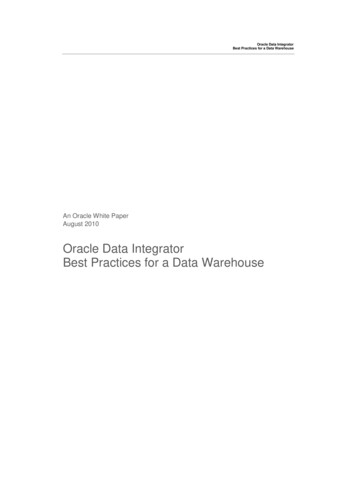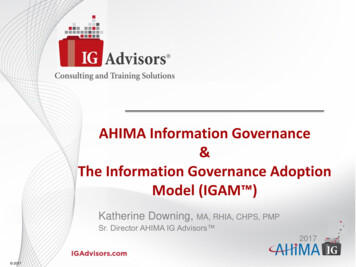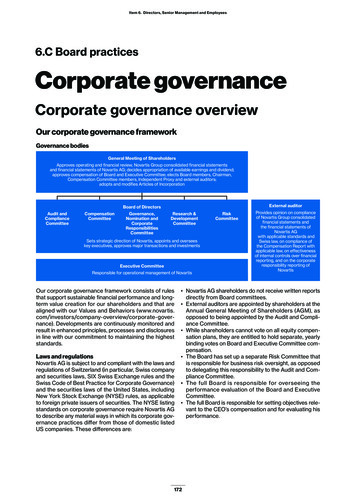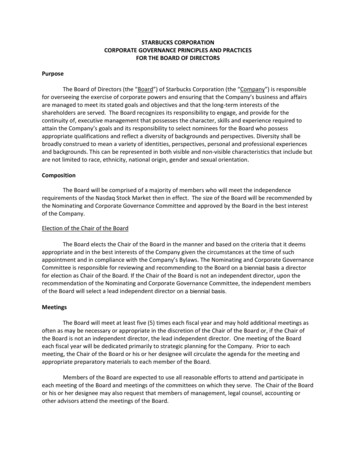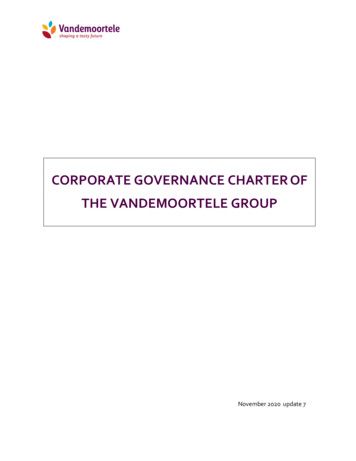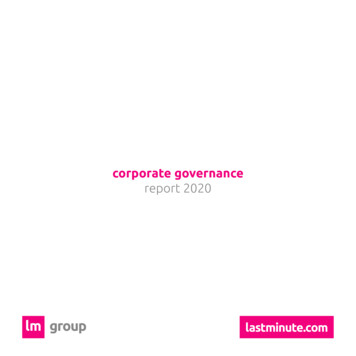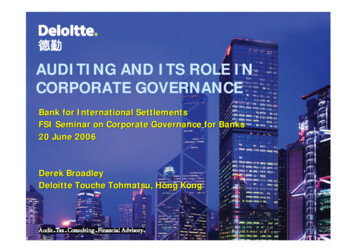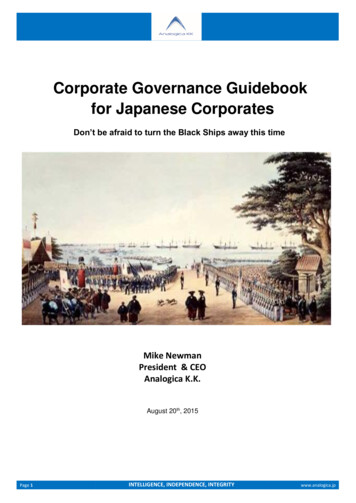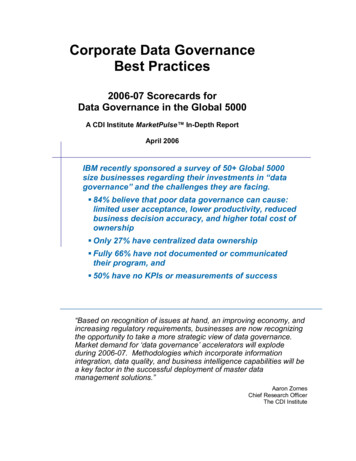
Transcription
Corporate Data GovernanceBest Practices2006-07 Scorecards forData Governance in the Global 5000A CDI Institute MarketPulse In-Depth ReportApril 2006IBM recently sponsored a survey of 50 Global 5000size businesses regarding their investments in “datagovernance” and the challenges they are facing.84% believe that poor data governance can cause:limited user acceptance, lower productivity, reducedbusiness decision accuracy, and higher total cost ofownershipOnly 27% have centralized data ownershipFully 66% have not documented or communicatedtheir program, and50% have no KPIs or measurements of success“Based on recognition of issues at hand, an improving economy, andincreasing regulatory requirements, businesses are now recognizingthe opportunity to take a more strategic view of data governance.Market demand for ‘data governance’ accelerators will explodeduring 2006-07. Methodologies which incorporate informationintegration, data quality, and business intelligence capabilities will bea key factor in the successful deployment of master datamanagement solutions.”Aaron ZornesChief Research OfficerThe CDI Institute
Corporate Data Governance Best Practices2006-07 Scorecards for Data Governance in the Global 5000Page 2TABLE OF CONTENTSExecutive Summary.1Introduction to Data Governance.1Why Data Governance? Why Now? .2Industry Scorecard Survey on “Data Governance Best Practices”.6Summary Survey Findings .7Detailed Survey Findings .9Overall Data Governance Plans .9Data Governance Approach: Plans, Methods & Communications .15Formal Roles & Responsibilities .16Data Cleansing & Enrichment Tools .18Measurements & Benefits .20Bottom Line - The Data Governance Juggernaut.27About the CDI Institute .30500 Airport Boulevard Suite 100 Burlingame, CA 94010 1 (650) 743.2278 Fax 1 (650) 651.1526 www.The-CDI-Institute.comCopyright 2006 The CDI InstituteAll rights reserved
Executive SummaryIntroduction to Data GovernanceA working definition of “data governance” is: “The formal orchestration ofpeople, processes, and technology to enable an organization to leverage dataas an enterprise asset.” Because data governance is a strategic initiativeinvolving multiple functions across the enterprise, a data governance programshould include a governing body (steering committee or council), an agreedupon common set of procedures, and a plan to communicate and executethose procedures.Businesses have been “governing” data for 20 years; however, only a rarefew are doing it well today. Historically, many companies assigned thegoverning of data to a data management group whose job it was to integrateand manage data. Today, more and more companies are recognizing theneed for a broader initiative to govern data—in particular, master data (aboutentities such as customer, product,Data Governance. The formal orchestrationand supplier), which is nowof people, processes, and technology torecognized as a critical asset thatenable an organization to leverage data asmust be managed within and beyond an enterprise asset.the enterprise.Because of escalating volumes andcomplexity, the challenges of datatoday are far greater than everbefore, requiring companies to breakdown the stovepipes separating dataacross divisions, so, too, datagovernance requires businesses tobreak down functional stovepipesand integrate people across theenterprise – including corporate anddivisional IT, all lines of business,functional areas, and geographicregions. Moreover, data governancemust engage all levels of IT andbusiness management across theenterprise. In other words, datagovernance is evolving to includecentralized or federated policymanagement – a.k.a. “processgovernance.” (See figure 1 fordefinitions of terms that will bediscussed in this paper.)Master Data Management (MDM). Theauthoritative, reliable foundation for dataused across many applications andconstituencies with the goal to provide asingle view of the truth no matter where itlies.Customer Data Integration (CDI).Processes and technologies for recognizinga customer and its relationships at anytouch-point while aggregating, managing andharmonizing accurate, up-to-date knowledgeabout that customer to deliver it ‘just in time’in an actionable form to touch-points.Master Data Integration (MDI). Process forharmonizing core business informationacross heterogeneous sources, augmentingthe system of record with rich content bycleansing, standardizing and matchinginformation to provide high data quality insupport of a master data managementinitiative.Source: The CDI InstituteFigure 1 – Definitions
Corporate Data Governance Best Practices2006-07 Scorecards for Data Governance in the Global 5000Page 2Why Data Governance? Why Now?Increasingly, businesses have determined that “You can't protect data if youdon't know what it is worth.” To know what it is worth, you have to knowwhere it is, how it is used, and where and when to integrate and federate it.In short, it is not possible to evaluate data from a business perspective if youdon't have a commanding or oversight-level IT perspective.“Information integration” – i.e., getting information that can be trusted to theright people and processes at the right time – is thus an essential ingredientof the IT and business processes collectively known as data governance.Once the value of corporate data is determined, the enterprise needs tocalculate the probability for risk in a business process. When managementunderstands the value of data and the probability of risk, it is then possible toevaluate how much to spend to protect and manage it, as well as whereinvestments should be made in adequate controls.This risk assessment is the basis of modern underwriting and increasingly afocus of IT portfolio management as businesses look to manage IT as assets– while understanding costs, risks, and controls. Doing this systematicallyrequires a combination of organizational structures, business processes, andtechnology.In other words, management of corporate data assets requires a “datagovernance blueprint” for:Data qualityInformation integrationBusiness intelligenceTherefore, a best practice within companies successfully implementing datagovernance is the collaboration between IT management and businessleadership to design and refine “future state” business processes associatedwith data governance commitments. Moreover, a strong data governancefunction is integral to delivering reliable and usable business information.Such a corporate data governance function can help businesses avoid thesesymptoms of poorly executing IT organizations:Overly complex IT infrastructureSilo-driven, application area-centric solutionsSlow-to-market delivery of new or enhanced application solutionsInconsistent definitions of key corporate data assets such as customer,supplier, and pricing mastersPoor data accuracy within and across business areas500 Airport Boulevard Suite 100 Burlingame, CA 94010 1 (650) 743.2278 Fax 1 (650) 651.1526 www.The-CDI-Institute.comCopyright 2006 The CDI InstituteAll rights reserved
Corporate Data Governance Best Practices2006-07 Scorecards for Data Governance in the Global 5000Page 3Line-of-business-focused data with inefficient or nonexistent ability toleverage information assets across lines of business (LOBs)Redundant IT initiatives to re-solve data accuracy problems for eachindividual LOBWith an operational data governance program, businesses are more likely tobenefit from:Uniform communications with customers, suppliers, and channels dueto the veracity and accuracy of key master dataCommon understanding of business policies and processes acrossLOBs and with business partners/channelsRapid cross-business implementation of new application solutionsrequiring shared access to master dataSingular definition and location of master data and related policies toenable transparency and auditability essential to regulatory complianceContinuous data quality improvement as data quality processes areembedded upstream rather than downstreamIncreased synergy between horizontal business functions via crossbusiness data usage – e.g., each LOB is able to cross-sell and upsellits products to the other LOBs’ customersWhile the business need for data governance is demonstrable across mostindustries, certain industries have special priorities – i.e., financial servicesproviders are extremely concerned about the security of customer financialdata; healthcare enterprises, about the privacy of patient medical data (HealthInsurance Portability and Accountability Act or HIPAA); and,pharmaceutical/life sciences enterprises, about compliance withmanufacturing regulations such as 21 CFR Part 11.Based on recognition of the current lack of focus on managing master data asa corporate asset, an improving economy, and ever-increasing regulatoryrequirements, companies are now clearly identifying an opportunity to take amore strategic view of data governance as both a tactical and a strategicinvestment.500 Airport Boulevard Suite 100 Burlingame, CA 94010 1 (650) 743.2278 Fax 1 (650) 651.1526 www.The-CDI-Institute.comCopyright 2006 The CDI InstituteAll rights reserved
Corporate Data Governance Best Practices2006-07 Scorecards for Data Governance in the Global 5000Page 4The Critical Role of the Data StewardA best practice within companies implementing data governance is theassignment of a data steward – or a combination of corporate data stewardsand business unit data stewards.The primary objective of the “datastewardship” role is to synchronizeDuring 2006-07, data governance willdata collection processes, reducebecome a mainstay of large scale CDIMDM projects as RFPs increasinglydata redundancy, and increasemandate that component.data accessibility, availability, andflexibility in a systematic manner — By 2008-09, data stewards will be acommon position in both ITi.e., to exercise quality control oforganizations and businesses asdata. There are typically twoenterprises formalize this functionvariants: “corporate data stewards” amidst increasing de facto and de jureand “business unit data stewards”recognition of information as acorporate asset.(reference Figure 3 for example oftypical organizational structureSource: 1H2006 MDM Road MapThe CDI Institutewithin Global 5000 enterprise tosupport data governance). GivenFigure 2 – Data Governance "Milestone”the pandemic shortage of suchformally trained staff, these positions need close attention by IT managementto ensure that the individuals they train up at considerable expense areretained within the organization.CDI Institute research analysts are seeing an increasing number of Centers ofExcellence (COEs) targeted at master data management — with the COEoperating both a data governance team and data stewardship team(s). Oftenthe data stewardship teams are segmented by customer type — e.g., highprofit/margin vs. high risk vs. low margin in financial service providers — orphysician vs. prescriber vs. Managed Care Organization (MCO)/plan vs.institutions in a pharmaceutical environment. These teams also deal with theconsiderable complexity and politics of managing inbound third-party datafeeds – from both business partners and commercial data service providerssuch as Acxiom, Dun & Bradstreet, and Experian.500 Airport Boulevard Suite 100 Burlingame, CA 94010 1 (650) 743.2278 Fax 1 (650) 651.1526 www.The-CDI-Institute.comCopyright 2006 The CDI InstituteAll rights reserved
Corporate Data Governance Best Practices2006-07 Scorecards for Data Governance in the Global 5000Page 5CIOChiefDataOfficerVP ofInfrastructureBusinessExecutiveVP ofApplicationsDept AExecDept BExecDept CExecData iness UnitDataStewardBusiness UnitDataStewardFigure 3 – Prototypical Data Governance Organizational Structure500 Airport Boulevard Suite 100 Burlingame, CA 94010 1 (650) 743.2278 Fax 1 (650) 651.1526 www.The-CDI-Institute.comCopyright 2006 The CDI InstituteAll rights reserved
Corporate Data Governance Best Practices2006-07 Scorecards for Data Governance in the Global 5000Page 6Industry Scorecard Survey on “Data Governance BestPractices”The data reported on in this whitepaper represents a CDI InstituteMarketPulse survey performedduring 1Q2006 on how companiesare investing in data governanceand the challenges they are facing.The survey sample targeted boththe CDI Institute’s Advisory Councilmembers and the Business Councilmembers, IBM’s Data GovernanceCouncil, and the IBM WebSphere Customer Center Client AdvisoryBoard (CAB). A number of the CDIInstitute’s Advisory Councilmembers assisted in the surveycreation process by helping identifyt
Corporate Data Governance Best Practices 2006-07 Scorecards for Data Governance in the Global 5000 A CDI Institute MarketPulse In-Depth Report April 2006 IBM recently sponsored a survey of 50 Global 5000 size businesses regarding their investments in “data governance” and the challenges they are facing. 84% believe that poor data governance can cause: limited user acceptance, lower .


